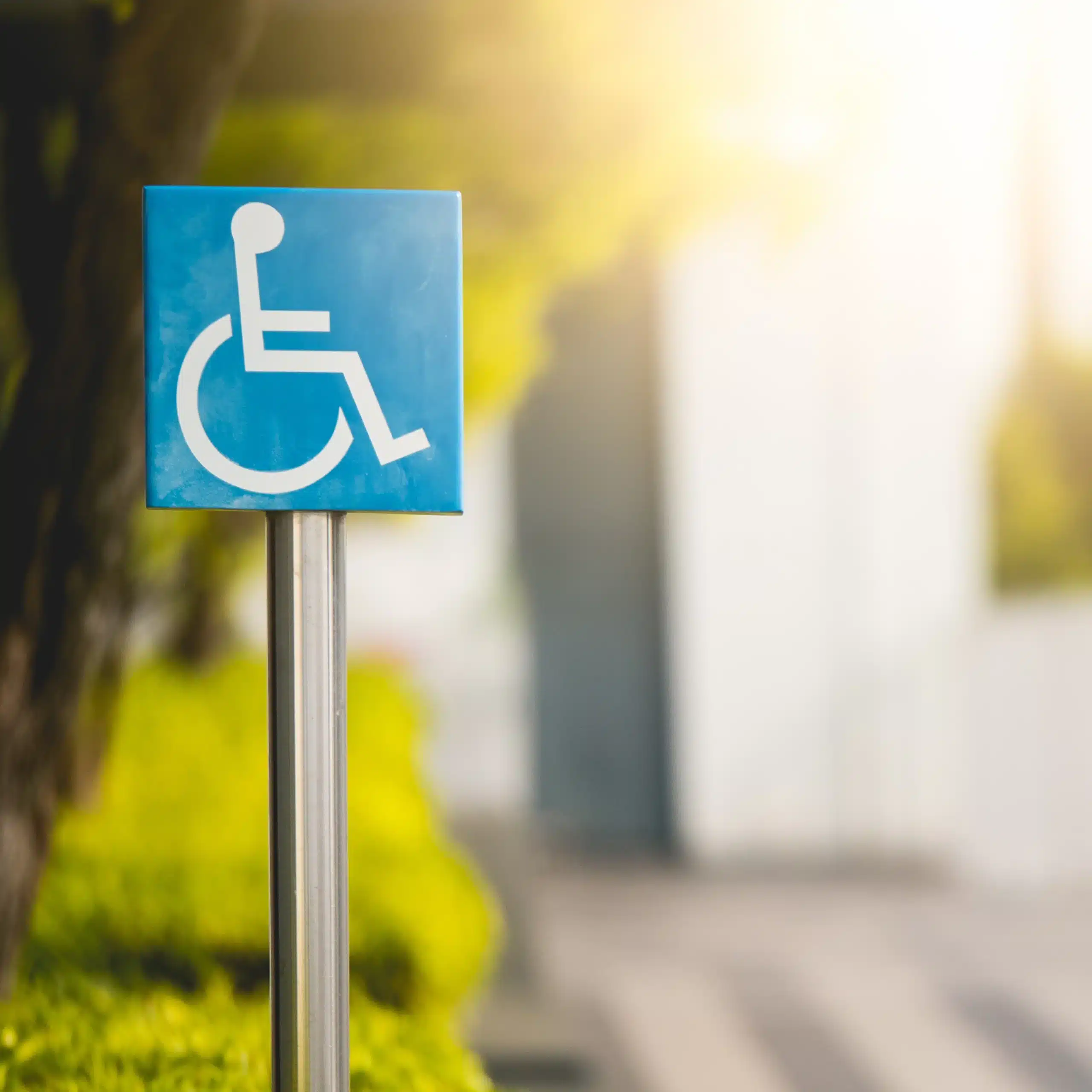RECENT POSTS
Categories
Empowering Accessibility: How Public Accommodation Laws Protect You
Navigating the world with a disability often means facing a labyrinth of challenges and obstacles that many take for granted. From the simple act of entering a building to accessing services that are a part of everyday life, the journey can be fraught with frustration and anxiety. This is especially true when visiting businesses and public spaces that are not designed with accessibility in mind. The Americans with Disabilities Act (ADA) was enacted to break down these barriers, yet the path to a fully accessible world is still under construction.
For many individuals living with disabilities, the world can sometimes feel like it's not made for them. The extra planning required for a simple outing, the uncertainty of whether a new place will accommodate their needs, and the sheer physical and emotional toll of navigating inaccessible environments can be exhausting. It's not just about the physical barriers; it's also about the feeling of exclusion and the reminder that the world often overlooks the needs of those with disabilities.
This blog aims to be more than just a source of information. It's a beacon of empowerment and understanding, shedding light on your rights under public accommodation laws as outlined in the ADA. Our goal is to arm you with knowledge, not just to navigate but to challenge and change the spaces that are yet to be inclusive. We understand the frustrations and the anxieties that come with disabilities, and we stand with you in the fight for a world where accessibility is not an afterthought but a fundamental right.
What is a Public Accommodation?
For individuals with disabilities, 'public accommodation' is more than a legal term; it's a key to the world. This concept, as defined by the ADA, encompasses the places and services that must be accessible to everyone, transcending physical or mental barriers. It's a promise that doors won't be closed, services won't be denied, and opportunities won't be out of reach due to a disability.
Understanding the Breadth of Public Accommodation
Public accommodation under the ADA is a broad term that encompasses a wide range of entities. It's not limited to government buildings or public transport; it extends to places where the public typically goes for goods, services, entertainment, or leisure. This includes hotels, restaurants, theaters, retail stores, gyms, and even places of education. Essentially, it's most of the places you visit in your daily life.
A Closer Look at What Constitutes a Public Accommodation
To truly grasp the scope of public accommodation, let's paint a picture of everyday life. Imagine planning a day out – perhaps a trip to a bookstore, a meal at a restaurant, followed by a movie. For someone with a disability, this ordinary plan can be laden with questions: Will there be a ramp or an elevator? Are there accessible restrooms? Will the staff understand and assist with my needs? Under the ADA, these aren't just conveniences; they're rights. Public accommodations are legally required to provide accessible facilities and services, ensuring that your day out is as enjoyable and stress-free as it should be.
The Diversity of Disabilities and Accommodations
It's important to remember that disabilities come in many forms – some visible, some not. Physical disabilities might require wheelchair ramps, Braille signage, or wider doorways. For those with hearing impairments, accommodations might include sign language interpreters or assistive listening devices. And for individuals with visual impairments, it could mean tactile guides or audible signals. The ADA covers this spectrum of needs, mandating that public accommodations make reasonable modifications to cater to various disabilities.
Your Rights Under Public Accommodation Laws
Under the ADA, businesses that serve the public and are considered public accommodations, must comply with specific requirements to ensure accessibility and non-discrimination for individuals with disabilities. These requirements are designed to guarantee equal access and incorporate inclusive design in all public spaces. Here are key provisions that businesses must adhere to:
- Ensure that new construction and alterations of their facilities comply with ADA Standards for Accessible Design.
- Remove architectural barriers in existing buildings where such removal is readily achievable (i.e., easily accomplishable and able to be carried out without much difficulty or expense).
- Example: Installing ramps at entrances, adjusting door widths to accommodate wheelchairs, and ensuring that public restrooms are wheelchair accessible.
- Make reasonable modifications to policies, practices, and procedures to accommodate people with disabilities, unless doing so would fundamentally alter the nature of the services.
- Example: A restaurant allowing a customer with diabetes to bring in outside food that meets their dietary needs.
- Provide auxiliary aids and services necessary for effective communication with individuals with hearing, vision, or speech impairments, unless doing so would fundamentally alter the nature of the goods or services or result in an undue burden (significant difficulty or expense).
- This can include providing sign language interpreters, Braille materials, large print materials, and assistive listening devices.
- Example: A movie theater providing closed captioning devices for movies or a doctor's office offering sign language interpreter services for patients who are deaf.
- Allow people with disabilities to bring their service animals into all areas of the facility where the public is normally allowed to go.
- Example: A grocery store allowing a customer with a visual impairment to bring their guide dog into the store, even where pets are generally not allowed.
- Hotels and other lodging facilities must ensure that they have a certain number of wheelchair-accessible rooms and provide amenities such as roll-in showers and visual alarms for guests who are deaf or hard of hearing.
- Example: A hotel offering rooms with roll-in showers, visual alarm alerts for guests who are deaf or hard of hearing, and ensuring that these accessible rooms are distributed across various price and room types.
- Ensure that aisles are wide enough for wheelchairs, and that items are within reach, or provide assistance in accessing items.
- Provide accessible seating and tables.
- Example: A clothing store ensuring that aisles are wide enough for wheelchair access and providing accessible fitting rooms; a restaurant ensuring that some tables are at an appropriate height for wheelchair users.
- Not discriminate against individuals with disabilities in their goods, services, facilities, privileges, advantages, or accommodations.
- This includes not refusing service, segregating customers, or providing a different quality of service due to someone’s disability.
- Example: A gym offering the same membership options and access to equipment for individuals with disabilities as for other members, without additional fees or restrictions.
Navigating the Exceptions of Public Accommodation Laws
While the ADA sets forth comprehensive guidelines to ensure accessibility for individuals with disabilities, there are specific exceptions and considerations within the law. These exceptions, such as those for historical buildings and small businesses, acknowledge certain practical limitations while still striving to uphold the spirit of accessibility and inclusion. This section explores these exceptions, helping to clarify when and why certain accommodations may not be required under the ADA.
Historical Buildings and Preservation
Historical buildings hold a unique place under ADA regulations. The preservation of their historical significance is often balanced against the need for accessibility. In cases where making the necessary modifications would significantly alter the building's historical character, exemptions may be granted.
However, this doesn't mean that such buildings are exempt from all ADA requirements. Alternative methods to ensure access, such as providing information through virtual tours or offering services at a different accessible location, are often required to ensure that individuals with disabilities can still engage with and enjoy these historical sites.
Small Businesses and Resource Constraints
Small businesses, particularly those with limited resources, face their own set of challenges in complying with ADA standards. The law recognizes these constraints and, in some cases, may offer flexibility.
For instance, small businesses are required to remove architectural barriers in existing buildings where it is "readily achievable" to do so, meaning without much difficulty or expense. This term is intentionally vague to account for the varying capacities of businesses. It might include simple changes like rearranging furniture, installing grab bars in restrooms, or adding a portable ramp. However, when extensive renovations are required, and the cost is prohibitive for a small business, full compliance may not be immediately enforceable.
Private Clubs and Religious Organizations
Private clubs and religious organizations are generally exempt from certain ADA compliance requirements, reflecting the balance between private operations and religious autonomy. This exemption applies to facilities strictly controlled by these entities, including places of worship and private membership clubs.
However, when these organizations offer services to the general public, like a restaurant in a private club, those areas must comply with ADA standards. While not legally obligated, many religious and private entities voluntarily adopt accessibility measures, recognizing the value of inclusivity.
Residential Properties
The ADA typically does not apply to private residences, distinguishing personal living spaces from public accommodations. Individual homes and apartments are exempt from ADA accessibility standards unless a portion is used for commercial purposes, like a home office open to clients.
However, residential facilities such as assisted living homes or public housing, serving multiple individuals, may have different requirements and are often expected to provide accessible features. This distinction is crucial for both residents and property managers in understanding where ADA protections are applicable.
It's important to note that these exceptions are not a blanket exemption from ADA compliance. Rather, they are acknowledgments of certain practical realities, with a focus still firmly on maximizing accessibility within those constraints.

The Consequences of Non-Compliance: Understanding the Risks and Challenges
When businesses overlook or neglect the guidelines set forth by the ADA, the repercussions extend far beyond legal penalties or fines. The real impact is felt by individuals with disabilities, who may face significant challenges or even risk injury due to these oversights. This section delves into the practical and often severe consequences of ADA non-compliance, both in terms of accessibility challenges and the potential for injury.
Accessibility Challenges Due to Non-Compliance
For many individuals with disabilities, an environment that does not adhere to ADA standards can transform a simple activity into an insurmountable challenge. Imagine a wheelchair user encountering a building without a ramp or an elevator – such a scenario effectively bars them from entry, denying them the services or experiences within. Similarly, a lack of proper signage or auditory assistance can leave those with visual or hearing impairments in a state of confusion and exclusion. These are not just inconveniences; they represent a fundamental denial of access and opportunity, reinforcing a sense of isolation and inequality.
Risk of Injury and the Premise Liability Implications
The failure to comply with ADA standards can also lead to more dire consequences, particularly when it results in injury. A slippery ramp without proper handrails, poorly maintained accessible facilities, or cluttered aisles that impede mobility aid navigation are not just violations of the ADA; they are hazards that can lead to falls, injuries, and other serious accidents. In such cases, the issue transcends basic accessibility – it becomes a matter of safety. These incidents fall under the purview of premise liability, where a business or property owner may be held legally responsible for injuries sustained due to their negligence in adhering to ADA guidelines.
It's crucial for businesses to understand that ADA compliance is not just a legal obligation but a moral one. By ensuring their premises are accessible and safe for all individuals, businesses not only adhere to the law but also contribute to a more inclusive and equitable society.
Seeking Justice: Legal Recourse for Injuries Under Public Accommodation Laws
Recognizing ADA violations is crucial, especially when these oversights lead to injury. A violation can range from the lack of necessary wheelchair ramps to insufficient signage for the visually impaired. These shortcomings are not only inconveniences; they can pose serious risks, turning public spaces into hazardous environments for individuals with disabilities. Understanding what constitutes a violation is essential, particularly when these issues compromise safety and lead to injury.
If you're injured due to such negligence, it's important to know the steps to take. While addressing minor ADA non-compliance issues might involve direct communication with the business or filing a complaint with the Department of Justice, injuries resulting from these violations fall under premise liability and warrant a different approach. In these cases, seeking legal assistance can be crucial. Wettermark Keith specializes in premise liability cases related to ADA non-compliance. Our experienced premises liability attorneys understand the intricacies of these situations and can offer the necessary legal support to ensure you receive the compensation you deserve. You can be confident we will represent you with compassion and expertise - and pursue your case to its conclusion. Remember, taking action in these scenarios is not just about seeking justice for yourself; it's about advocating for a safer, more inclusive environment for everyone.
Frequently Asked Questions
A reasonable accommodation is a modification or adjustment to a job, the work environment, or the way things are usually done that enables an individual with a disability to enjoy equal employment opportunities. This includes accessibility features in public spaces, such as ramps, modified restrooms, and signage for the visually impaired. The accommodation must be feasible without causing undue hardship to the business.
Most businesses that serve the public are required to comply with ADA standards, especially those classified as “public accommodations” like restaurants, hotels, theaters, and retail stores. However, there are exceptions, such as certain private clubs, religious organizations, and private residences not used for commercial purposes.
If you encounter an ADA violation, it's often best to first discuss the issue with the business owner or manager. Many businesses are willing to make necessary changes once an issue is brought to their attention. If the problem persists, you can file a complaint with the Department of Justice, which handles ADA violation cases. However, if you have been injured due to an ADA violation, such as a fall due to inadequate accessibility features, this may constitute a premise liability case. In such situations, seeking legal advice is advisable, and our law firm specializes in handling cases where ADA non-compliance results in injury. We are here to assist you in understanding your rights and exploring legal options in the context of premise liability and injury due to ADA violations.
Historical buildings are subject to ADA standards, but they are also given certain flexibilities. If making the necessary modifications would significantly alter the building's historical character, alternative methods to ensure access, such as virtual tours or off-site accessible services, might be considered. However, efforts should still be made to increase accessibility as much as possible without compromising historical integrity.
Yes, public accommodation laws differ by state, complementing the federal baseline established by the Americans with Disabilities Act (ADA). States often enact their own regulations, which can provide greater protections, encompass a wider array of businesses, and adopt broader definitions of disability. While these state laws enhance the ADA's provisions, they cannot reduce the federal protections, only build upon them.
Public accommodation laws and the Americans with Disabilities Act (ADA) are closely related but not exactly the same. The ADA is a federal law that provides a broad framework for protecting the rights of individuals with disabilities, including their right to access public accommodations. Under the ADA, public accommodations are defined as private entities that own, lease, lease to, or operate facilities such as restaurants, hotels, theaters, and retail stores, and they must provide equal access to individuals with disabilities.
Public accommodation laws, on the other hand, can refer to both the ADA and any additional state or local laws that govern access to public spaces for individuals with disabilities. While the ADA sets the minimum standard, some states and localities have enacted their own laws that further expand or detail these requirements. These state and local laws can offer greater protections or cover additional circumstances beyond what is outlined in the ADA.
While the ADA is a key component of public accommodation laws, the term "public accommodation laws" encompasses both the federal ADA standards and any related state or local regulations.
Ready to work together? Contact us today for a free consultation.
HERE'S WHAT TO DO NEXT
If you or a loved one have been injured and think you might have a case, call us now for a free consultation.


